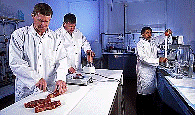United States Department of Agriculture: Agricultural Research Service, Lincoln, Nebraska
Date of this Version
1-2004
Document Type
Article
Citation
Agricultural Research Service U.S. Department of Agriculture, January 2004.
Abstract
Breeds with differences in performance characteristics are an important genetic resource for improving efficiency of beef production. Diverse breeds are required to exploit heterosis and breed complementarity through crossbreeding and development of Composite populations to match genetic potential with different markets, feed resources and climates. Beef producers are under increasing pressure to reduce fat while maintaining or improving tenderness and palatability of products. No single breed excels in all traits of economic importance to beef production. This report presents preliminary results from Cycle VII of the Germplasm Evaluation Program (GPE) at the Roman L. Hruska U.S. Meat Animal Research Center (U.S. Meat Animal Research Center) which focused on characterization of the seven Bos taurus breeds that register the largest number of animals in their respective herd books. Each breed, except Red Angus, had been characterized in earlier Cycles of the Germplasm Evaluation Program as shown in Table 1. The objective of Cycle VII was to evaluate relative changes in these breeds since they were evaluated with samples of sires born 25-30 years earlier and to provide a current evaluation of these prominent Bos taurus breeds.


